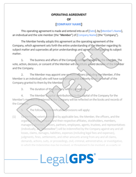Trademarks Made Easy: 7 Steps Every Business Should Follow
This guide--part of our intellectual property series--helps you determine if you should register your mark for trademark protection. You’ll want to...
5 min read
Admin : Oct. 14, 2024
Registering a trademark in the United States can seem like a complex process, but breaking it down step by step makes it much more manageable. This guide will walk you through everything you need to know, from choosing the right application to filing with the United States Patent and Trademark Office (USPTO). Let’s dive in and make sure your brand is well protected.


Legal GPS Pro
Protect your business with our complete legal subscription service, designed by top startup attorneys.
When applying for a trademark, you have two options: TEAS Plus and TEAS Standard. Each has its own benefits, so it’s important to choose the one that fits your needs.
TEAS Plus: Costs $250 per class of goods/services. It has stricter requirements, including using the predefined goods and services from the USPTO's Trademark Identification (ID) Manual. If you can meet these requirements, TEAS Plus is the cheaper option and has a lower chance of refusal.
TEAS Standard: Costs $350 per class of goods/services. This option gives you more flexibility to describe your goods or services, which can be helpful if your product doesn’t fit into the existing categories in the ID Manual.
Action Step: Decide which application type makes sense for your business. If you can find a suitable description in the ID Manual, go with TEAS Plus to save money and increase your chances of a smoother process.
The next step is to create a drawing of your trademark. This isn't a literal drawing but rather a depiction of how your trademark will look. There are different types of marks you can register:
Standard Character Mark: This is the simplest type, where your trademark is just the text of your brand name. This option allows you to use the mark in any font, color, or size.
Special Form Mark: This includes logos, designs, or specific fonts/colors. You’ll need to provide an image of the mark exactly as you plan to use it.
Sound Mark: If your trademark is a sound, like the famous MGM lion’s roar, you need to submit an audio file.
Example: If you want your brand name protected regardless of how it’s displayed, go for a Standard Character Mark. But if you have a logo with unique colors and fonts, you’ll need to file a Special Form Mark.
Action Step: Decide on the type of mark that best represents your brand. Make sure your depiction is accurate, as it will appear on your trademark certificate and cannot be easily changed.
Protect Your Business With IP Rights
One of the most critical parts of the application is accurately describing your goods or services. The USPTO provides an ID Manual that lists common descriptions for various goods and services.
Goods are tangible items that you sell, like clothing, electronics, or books.
Services are activities you perform for customers, like consulting, photography, or web design.
Example: If you’re a photographer, you might list “photography services” under services and “photographic prints” under goods if you also sell prints of your photos.
Action Step: Use the ID Manual to find the most accurate descriptions for your goods or services. If there’s no suitable description, you can write your own, but keep in mind that this increases the risk of refusal.
You need to select a filing basis for your application. There are two common filing bases:
Section 1(a) – Use in Commerce: This means you are already using the trademark in commerce. You’ll need to submit a specimen (an example of how the trademark is being used, like a product label or screenshot of your website).
Section 1(b) – Intent to Use: This means you haven’t started using the trademark yet but plan to in the near future. You will need to submit proof of use later.
Example: If you’re selling T-shirts with your logo, choose Section 1(a) and provide a photo of the T-shirt as a specimen. If you’re launching a new product line next year, choose Section 1(b).
Action Step: Determine if you are currently using the trademark or if you plan to use it soon. Gather any specimens if you’re filing under Section 1(a).


Legal GPS Pro
Protect your business with our complete legal subscription service, designed by top startup attorneys.
Once you’ve gathered all the necessary information, it’s time to complete the online application using the Trademark Electronic Application System (TEAS). Here are some key sections to pay attention to:
Owner Information: Make sure the owner’s name is correct. This could be you personally or your business entity.
Correspondence Information: Provide accurate contact details so you don’t miss any important communications from the USPTO.
Signature: Sign electronically by typing your name between two slashes (e.g., /Jane Doe/).
Action Step: Double-check all the information before submitting. Mistakes can lead to delays or even rejection of your application.
Once the application is complete, you’ll need to pay the filing fee. Remember, this fee is non-refundable, even if your application is denied, so make sure everything is correct before submitting.
TEAS Plus: $250 per class of goods/services.
TEAS Standard: $350 per class of goods/services.
Action Step: Pay the fee and save the confirmation receipt. This will be your proof that the application was submitted.
After submission, your application will be reviewed by a USPTO examining attorney. This process can take anywhere from six months to over a year, depending on the specifics of your application.
Office Actions: If there are issues with your application, you may receive an Office Action, which is a letter detailing any problems. You’ll need to respond within six months to keep your application active.
Publication for Opposition: If your application passes the initial review, it will be published in the Trademark Official Gazette. This gives others a chance to oppose your registration if they believe it conflicts with their trademark.
Action Step: Regularly check the status of your application using the USPTO’s Trademark Status and Document Retrieval (TSDR) tool. Respond promptly to any Office Actions to avoid delays.
If no one opposes your application, your trademark will be registered, and you’ll receive a Certificate of Registration. To maintain your trademark, you’ll need to file maintenance documents periodically.
Between Years 5 and 6: File a Declaration of Use to prove you’re still using the trademark.
Every 10 Years: File a Renewal to keep your trademark active.
Action Step: Set reminders for maintenance filings to ensure your trademark remains protected.
Registering a trademark in the USA is a detailed process, but taking it step by step makes it manageable. Whether you’re applying with TEAS Plus or TEAS Standard, the key is preparation—know your goods and services, choose the right filing basis, and provide accurate information. With proper care, your trademark can become a powerful tool for protecting your brand.
The biggest question now is, "Do I need a business lawyer?” For most businesses and in most cases, you don't need a lawyer to start your business. Instead, many business owners rely on Legal GPS Pro to help with legal issues.
Legal GPS Pro is your All-In-One Legal Toolkit for Businesses. Developed by top startup attorneys, Pro gives you access to 100+ expertly crafted templates including operating agreements, NDAs, and service agreements, and an interactive platform. All designed to protect your company and set it up for lasting success.

Legal GPS Pro
Protect your business with our complete legal subscription service, designed by top startup attorneys.

100+ legal templates, guides, and expert advice to protect your business.
Trusted by 1000+ businesses
Table of Contents

This guide--part of our intellectual property series--helps you determine if you should register your mark for trademark protection. You’ll want to...

If you've successfully filed a trademark application, congratulations—you've completed an important step in securing your brand. But to maintain your...

Now that your trademark is registered, it's crucial to take steps to protect it. Trademark protection is an ongoing process that helps ensure your...